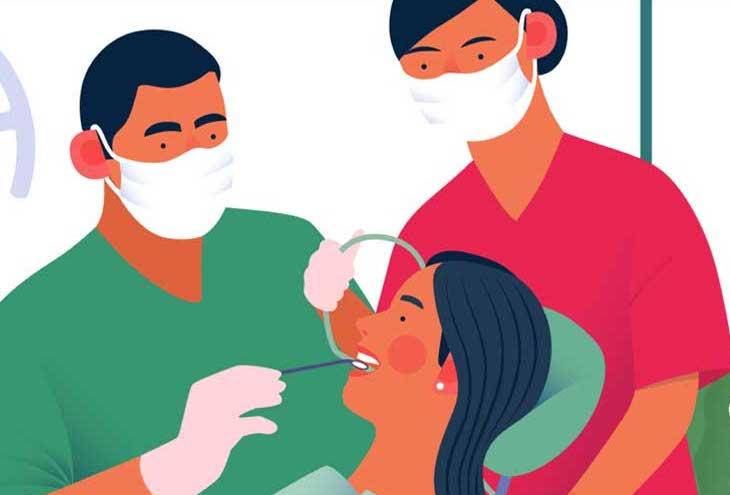Beyond maintaining your winning smile, dental care is crucial in promoting overall health and well-being. But Native Americans continue to face disparities — and tribes continue to face unique challenges — in accessing care.
Despite improvements, dental health disparities remain at crisis levels. The prevalence of tooth decay in Native children is four times higher than the national average. Untreated cavities, periodontal disease, oral pain, and missing teeth affect Native American adults at a much higher rate than the general population. Afflictions that cause mouth pain often lead to poor eating habits, which triggers a domino effect of health problems.
The Indian Health Service (IHS) provides dental services at 59 centers and 26 hospitals, all free to registered members of federally recognized tribes. But 40 percent of Native people are ineligible for these services because their tribe is not federally recognized or they don’t meet enrollment requirements.
And then there’s funding. Although the 2023 budget for IHS has increased to $9.1 billion, the portion allotted to dental care doesn’t cover sufficient hiring. Currently, IHS employs only 300 dentists — roughly one for every 7,000 eligible patients. However, the budget has increased this year, and there were 202 dental health positions open at the time of publication.
Confronting a crisis
Many tribes are taking proactive steps to improve the oral health of their members through a combination of traditional practices, community initiatives, and partnerships with outside organizations.
One approach is to establish their own dental clinics, staffed by tribal members with specialized training. These clinics may offer a range of services, from routine cleanings and checkups to more complex procedures like root canals and extractions. The Navajo Nation Dental Clinic and the Cherokee Indian Hospital Dental Clinic are two tribal facilities that have partnered with outside organizations to provide dental care.
Prevention and education programs can also do much to close the dental care gap. Advice on oral health can be accessed at free online resources like Delta Dental and the Centers for Disease Control, and some tribes have set up school-based programs where dental professionals go on-site to provide screenings and oral health education. Then there are community-wide initiatives, such as fluoridating water supplies.
Cultural practices also play a role in dental health. Some traditional diets incorporate foods like wild salmon and berries, which are rich in nutrients that promote oral health. Others use traditional medicines, like cedar bark and juniper, to help prevent and treat dental problems.
Augmenting available care
The most impactful solution entails adding dental care providers, but that solution can’t depend on an abundance of dentists. After all, it takes eight to 13 years of expensive post-secondary education to produce one dentist. Furthermore, it would require approximately $100,000 per year to employ that one dentist at an IHS facility. Creating more dental health jobs that require fewer skills and cost significantly less is a more practical solution. Here are some paths to a more equitable future in dental health.
Dental health aide therapists (DHATs) are licensed to fill cavities and perform extractions and other restorative procedures after two years of training and three months of clinical experience. Additionally, DHATs can work remotely in consultation with a supervising dentist, making them a valuable asset in providing care to isolated communities. The Alaska Native Tribal Health Consortium (ANTHC) provides training and clinical experience for DHATs, allowing them to earn the required credentials quickly and return to their communities. This model enables tribal nations to train and employ their own people, fostering a greater degree of tribal sovereignty. Since 2004, DHATs employed in Alaska have expanded access to oral health care for over 40,000 people.
Dental hygienists operate in tandem with dentists to examine and educate patients. They perform preventive procedures like routine cleanings, scaling, and polishing and take x-rays. Dental hygiene programs usually require a high school diploma and typically take two to three years. After graduation, dental hygienists must pass a licensing exam.
Dental assistants work closely with dentists and hygienists. They may prepare examination rooms, aid in complex procedures, collect patient histories, sterilize equipment, take x-rays, and provide patients with information on oral hygiene. Dental assistant training programs, which typically require a high school diploma, are offered at community colleges and vocational and technical schools. These programs generally take several months to a year and graduates earn a certificate or diploma. Rather than completing a formal training program, some dental assistants acquire several months of on-the-job training. While optional, obtaining certification through the Dental Assisting National Board (DANB) can boost job career potential.
Dental laboratory technicians design and fabricate dental appliances such as crowns, bridges, and dentures and may mend damaged ones following instructions from dentists. Dental lab technician training programs, typically offered at community colleges and technical and vocational schools, can take anywhere from several months to two years and lead to a certificate, diploma, or associate degree. In lieu of a formal program, some lab technicians receive several years of on-the-job training supervised by an experienced technician.
Dental public health professionals strive to promote oral health and avert dental diseases at a population level. They may work for government agencies, nonprofits, or private organizations to create and execute public health programs, conduct research, and educate the public about oral health topics. This role requires a blend of education and training in dentistry and public health, including a bachelor’s degree, dental degree, dental public health residency, public health training, licensure, and certification.













